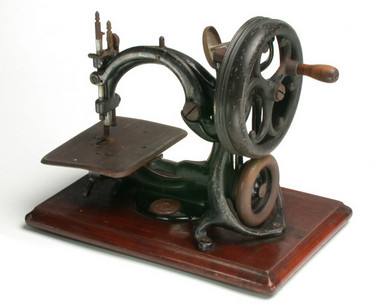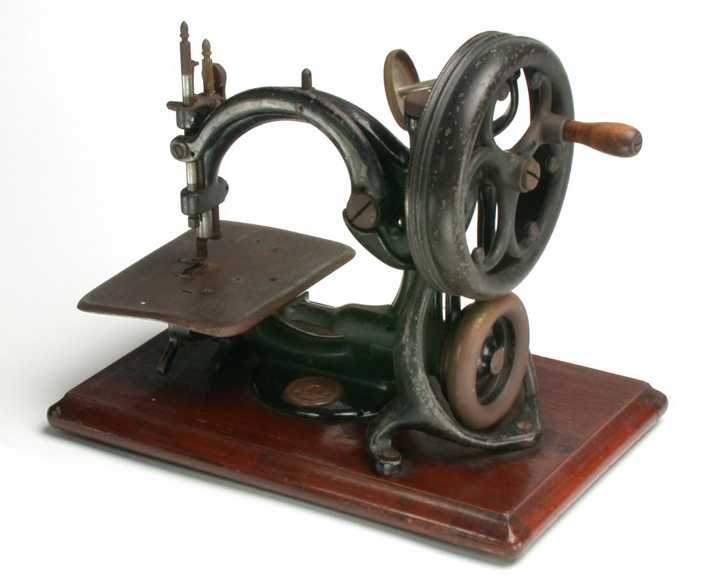Sewing Machine, Victorian, Original
Machines for sewing were developed throughout the early part of the 19th century but it wasn't until the 1850s, when seams could be sewn continuously, that they became popular, both commercially and domestically. Machines of the 1850s were heavy, cumbersome and expensive and not ideal for home use. Then the American manufacturers Willcox and Gibb developed an inexpensive and lightweight machine that was immediately popular.
The sewing machine shown here is a Willcox and Gibb machine from 1871- their name is inscribed on a circular metal plaque on the base of the machine. The machine is made out of iron and painted black and is mounted on a solid wooden platform to give it stability. It is operated by turning the handle at one end, which drives a belt (missing in this picture) that in turn drives both the needle and the bobbin. Originally the machine had an intricate pattern of intertwining leaves painted on it in gold, but this has rubbed off with time.
The sewing machine shown here is a Willcox and Gibb machine from 1871- their name is inscribed on a circular metal plaque on the base of the machine. The machine is made out of iron and painted black and is mounted on a solid wooden platform to give it stability. It is operated by turning the handle at one end, which drives a belt (missing in this picture) that in turn drives both the needle and the bobbin. Originally the machine had an intricate pattern of intertwining leaves painted on it in gold, but this has rubbed off with time.

Height:27cm

Height:27cm

Machines for sewing were developed throughout the early part of the 19th century but it wasn't until the 1850s, when seams could be sewn continuously, that they became popular, both commercially and domestically. Machines of the 1850s were heavy, cumbersome and expensive and not ideal for home use. Then the American manufacturers Willcox and Gibb developed an inexpensive and lightweight machine that was immediately popular.
The sewing machine shown here is a Willcox and Gibb machine from 1871- their name is inscribed on a circular metal plaque on the base of the machine. The machine is made out of iron and painted black and is mounted on a solid wooden platform to give it stability. It is operated by turning the handle at one end, which drives a belt (missing in this picture) that in turn drives both the needle and the bobbin. Originally the machine had an intricate pattern of intertwining leaves painted on it in gold, but this has rubbed off with time.
The sewing machine shown here is a Willcox and Gibb machine from 1871- their name is inscribed on a circular metal plaque on the base of the machine. The machine is made out of iron and painted black and is mounted on a solid wooden platform to give it stability. It is operated by turning the handle at one end, which drives a belt (missing in this picture) that in turn drives both the needle and the bobbin. Originally the machine had an intricate pattern of intertwining leaves painted on it in gold, but this has rubbed off with time.




















